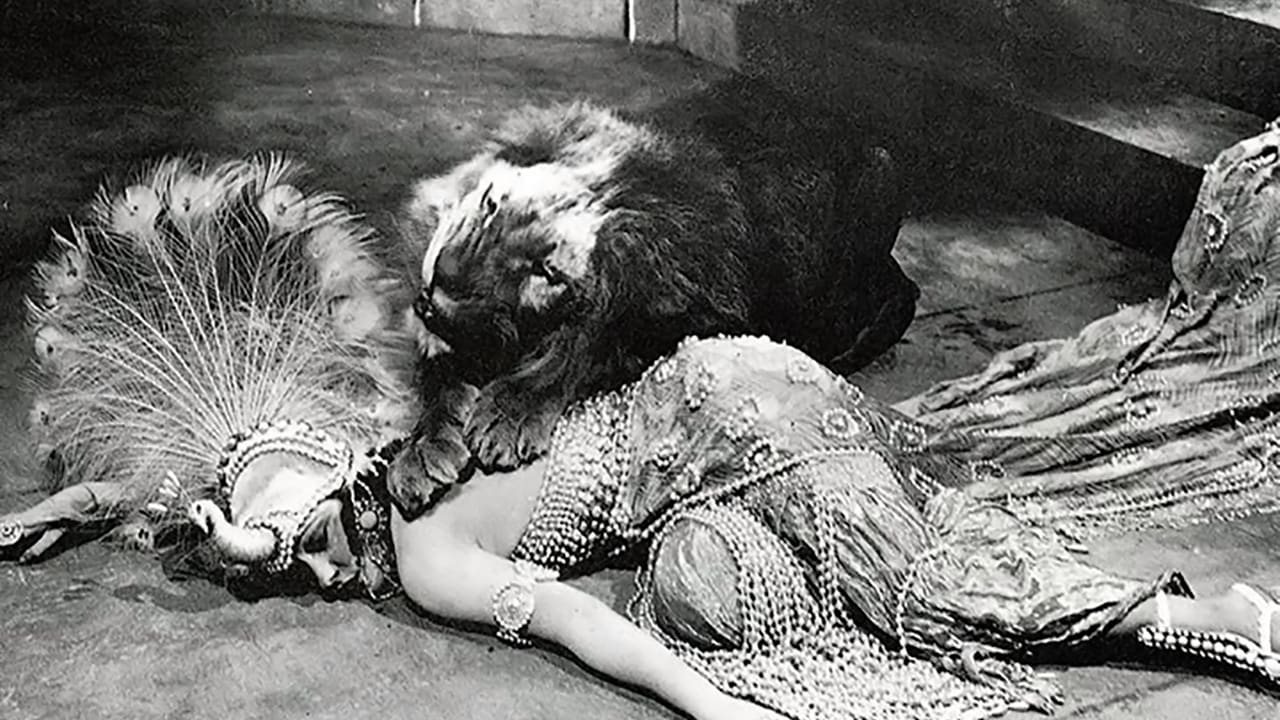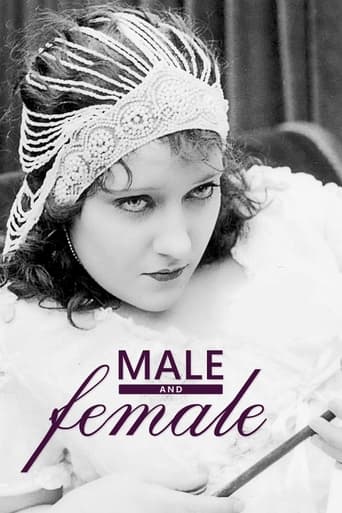

"Male and Female" (1919) is now available from Alpha in a 57 minutes version. Well, actually it's not what you would call a version. My guess is that some collector or library had a pristine 16mm copy, but somehow managed to mislay reel two. So, in the Alpha version we get a sudden cut of the yacht sailing away from merry England to a scene in ancient Babylon. So although we encounter the lions all right, we miss all the stuff about the shipwreck, the arrival on the island and the sorting out of who's-in-charge. But we do see the rescue and all the back-in-England scenes. Enough of the film survives at Alpha to sustain our interest and appreciate all the fine acting from Thomas Meighan (a subtle, well-shaded performance), Gloria Swanson (in her vampish element here), Lila Lee (as the entrancing Tweeny) and most particularly Rhy Darby – in her only movie appearance – as the lovely, titled lady who wants to marry her chauffeur (played with just the right blend of lower-class charisma by Henry Woodward).
... View MoreIn the beginning we are introduced to a genuine old British aristocratic family: the spoiled, lazy Lady Mary, her quirky father and her younger sister. And, of course, Lady Mary is engaged to another aristocratic parasite, Lord Brockelhurst. And, on the 'other side of the fence', are the servants: butler Crichton, who is secretly in love with Lady Mary (although this is of course 'impossible': you can't break out of your 'caste'...), and maid Tweeny who in turn is in love with Crichton. A typical picture of old aristocratic England...... Until one day, when the blue-blooded clan starts out on a South Sea cruise - and are stranded there on a lonely island; without luxury, without lodgings, even without food. And NOW it shows WHO is able to survive when being put to the test: Crichton with his energy and inventive spirit soon becomes the leader of the 'Swiss Family Robinson', while Lady Mary, completely helpless on her own, must admit that now HE's the strong man, HE's the 'King' (he even dreams of being the King of Babylon and she his Christian slave...) - and falls in love with him, while Tweeny jealously has to stand by and watch... BUT if they'll ever be rescued and return to England, will everything be as it was before?? This early work of Cecil B. De Mille already shows pretty clearly his vivid fantasy and love for ancient settings and costumes, as well as his belief in old-fashioned morales and institutions. The best part is, of course, when Crichton becomes the 'King', wild and strong, far away at last from his stiff butler image (Thomas Meighan, with his cocksure and almost a little menacing expression, somehow seems to look here like a kind of Rudolph Valentino 10 years older...), and Lady Mary alias Gloria Swanson, in the new surroundings of the wilderness, at last becomes a REAL woman. But - will it last??
... View MoreJ.M. Barrie's "The Admirable Crichton" opened on London's West End in 1902 and ran for a staggering 828 performances, the next year it came to Broadway. The play differed from the film in that (in the play) Lord Loam considered class division artificial and during tea parties, servants were expected to mingle with the guests as equals - only Crichton, the butler disapproves, feeling everyone should know their place.The Loam family are introduced as upper class twits with more money than sense. The house is run by the servants - in particular, Crichton (Thomas Meighan), the Loam's dignified butler, who is always at the ready to show people the right way of doing things (especially adoring scullery maid Tweeny (Lila Lee) and boot boy, Buttons (Wesley Barry)). The family beauty - Lady Mary (gorgeous Gloria Swanson) is completely spoilt and has servants to cater to her every whim, from seeing her bathwater is just the right temperature to making sure her toast is not too soft. There is a wonderful bathroom scene, with all the most modern conveniences, including luxurious rose water spraying from a fountain.The Loams go on a South Sea cruise but disaster strikes as their boat hits a rock and they have to make their way to an uninhabited island. True characters come to the fore, the family are lazy and expect their servants to obey their every whim. Crichton soon shows himself a true leader and everyone in the party turns to him for guidance. Two years pass and everyone is living together as equals and pulling their weight, there is no master or servant - all except Crichton, who is now the supreme leader. Mary and Tweeny now fight for the opportunity to serve him supper. Being a DeMille production, there is a spectacular Biblical scene (maybe his first) with Meighan as a bored, callous King, Bebe Daniels as a saucy slave girl and Gloria Swanson as a beggar maid, who goes to the lion's den rather than put aside her Christian principles.They are eventually rescued and Crichton and Lord Loam are the first to remember their "places" in the world. Lady Mary can't forget her love, they were just about to be married when the rescue boat is seen. Back in civilization, Lord Brockelhurst resumes his courting of Mary - all through the film he has shown himself to be pretty flirtatious with Mary's maid - you know when Mary accepts his proposal - her life will not be a happy one. Crichton hides his true feelings about Mary and when she is visited by an old friend who has defied her family, married her chauffeur and lived to regret it - he impulsively asks Tweeny to marry him. They will leave service and sail for America, where everyone is equal (the last scene is particularly sweet as Crichton walks to a farmhouse after finishing ploughing for the day, to find Tweeny waiting for him.)I do agree, I think the titles are profuse and flowery and excessive - they would do credit to a William S. Hart western!!! I also think Thomas Meighan was born for this role - he was manly and masterful. He was also excellent in "Why Change Your Wife?" - Cecil B. DeMille obviously liked him a lot as he popped up in quite a few of his movies. Although Barrie had considered ending his play with Crichton and Mary continuing their affair, even after Lady Mary is married, he decided on a more conventional ending as he thought "the stalls wouldn't like it"!!!Highly, Highly Recommended.
... View More"Male and Female" is another of Producer/Director Cecil B. De Mille's comedy/dramas. This one is about role reversal and makes one think of "Gilligan's Island" the farcical TV series that was popular in the 60s.The Loam family is a group of spoiled upper crust British nobles which include Lord Loam (Theodore Roberts), his daughters Lady Jane Lasenby (Gloria Swanson) and Agatha Lasenby (Mildred Reardon) along with Agatha's husband or suitor (I'm not sure which) The Honorable Ernest Wolley (Raymond Hatton). They are served by the butler Crichton (Thomas Meighan) and maid Tweeney (lila Lee). Crichton is secretly in love with Lady Jane but despises her spoiled antics ("The toast is too soft, Crichton"). Tweeney is in love with Crichton and so it goes.Lady Jane becomes engaged to marry the stuffy Lord Brockelhurst (Robert Cain) much to the dismay of Crichton. The family plans a south seas cruise and brings along Crichton, Tweeney and a young minister named Treherne (Edmund Burns). The party is ship wrecked on a remote island. Being of the spoiled upper class, the family is unable to cope with living in the wilderness. Crichton steps up and gradually takes command of the situation.The family at first rejects the idea of taking orders from their servant, but soon hunger and the need for shelter prevail. The family members gradually pitch in and learn to live off the land. Crichton seems to enjoy the role reversal where Lady Jane and Agatha are now forced to serve him. Two years pass.After Crichton rescues Lady Jane from a leopard, we are transported in Crichton and Lady Jane's imagination to ancient Babylon where Crichton is the King and Lady Jane a Christian. The King has a favorite (Bebe Daniels) who languishes at his feet in a web like head dress. When the Christian refuses to be a slave to the king, she walks into the lion's den and is eaten.Cut back to the present where Crichton and Lady Jane plan to be marries by Treherne. Just as the ceremony is being performed, Tweeney spots a passing ship and the party is rescued. They return to England where..............................................................Its hard to imagine that no hanky panky went on during the party's two year odyssey but that's what we're supposed to believe. The flashback sequence though lavishly staged is really unnecessary.The performances are generally good. Gloria Swanson was born to play the spoiled rich girl and looks lovely doing so. Lila Lee is equally beautiful as the love lorn Tweeney. Theodore Roberts and Raymond Hatton are mere cartoon characters. But it is Thomas Meighan who stands out. Being head and shoulders taller than the diminutive Ms. Swanson, he exudes leadership, authority and male virility as Crichton.It's not a bad movie but I challenge you not to think of "Gilligan's Island" when watching it.
... View More